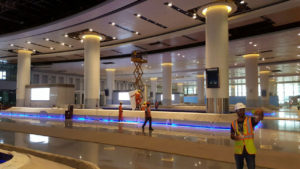by Ben Taylor
Ongoing revival of Air Tanzania
President Magufuli rapidly carried through on his promise, made in early 2016, to purchase two new aircraft for the troubled national airline, Air Tanzania. The airline took delivery of two 76-seater Bombardier Q400 planes in September, at a cost of $62m to the taxpayer. The aircraft immediately entered service, expanding the fleet from one to three planes, and providing routes between Dar es Salaam and Mwanza, Bukoba, Kigoma, Mbeya, Dodoma, Kilimanjaro, Arusha, Zanzibar and the Comoros.
In December, the president placed orders for three new aircraft for national and regional routes, including a third Q400 and two 150-seat Bombardier CS300 craft, at a total cost of $203m. But the shopping spree did not stop there, with one further plane ordered: a Boeing 787 Dreamliner for use on long-haul routes with space for around 250 passengers. With an estimated price tag of $225-265m, this brings the total taxpayer spend on the airline to around $500m in a single year.
The new planes purchased by the government are owned by the state-run Tanzania Government Flight Agency (TGFA), but will be operated by ATCL. The choice of planes was said to have been influenced by President Kagame of Rwanda.
ATCL’s local competitors, Precision Air and the budget airline FastJet, have both faced difficulties in recent months. FastJet, having grown rapidly since its entry into Tanzania around four years ago, recently sold one aircraft and returned three leased craft in an effort to cut costs. Precision Air has been posting losses, and is said to be seeking funds to recapitalise. Both airlines have struggled to fill planes to full capacity.
According to a statement from the president’s office, the government plans for ATCL to add non-stop direct flights between Tanzania and Asian and European tourism markets in a bid to boost annual foreign visitor arrivals beyond current levels of around 1 million.
“Tourists have to use several connecting flights to come to Tanzania… this is because we don’t have our own (strong) airlines,” Magufuli was quoted as saying in the statement. “We haven’t even reached 2 million tourist arrivals a year, while a country like Morocco gets more than 12 million tourists each year,” the president remarked. (The Guardian, Daily News)
Progress on Dar es Salaam airport Terminal III, regional airports
While on an inspection visit to Julius Nyerere International Airport, Minister for Works, Transport and Communication, Prof Makame Mbarawa, outlined the potential of the new, modern terminal building. It is set to accommodate over six million passengers each year, more than triple the airport’s current capacity, and will include shopping malls and several other business outlets offering an estimated 5,000 job opportunities.
The opening of the new terminal building, which was originally scheduled for mid-2016, has been pushed back to December 2017. The construction cost is now estimated at TSh 650bn, up from the original estimate of TSh 570bn.
Further afield, Songwe airport in Mbeya is currently under construction, expansion is underway at Mwanza airport and work is planned in Kigoma. The runway at Dodoma has recently been extended, allowing larger aircraft to serve the nation’s capital city.
Meanwhile, minister Mbarawa directed the Immigration Department, Tanzania Revenue Authority (TRA) and National Microfinance Bank (NMB) to facilitate a smoother issuance of visas to foreign passengers arriving at JNIA’s Terminal II. He gave the instruction after observing what to many will be a familiar sight of long queues of passengers waiting for visas at the terminal. (The Guardian)
Funds secured from China for rail expansion work
Export Import Bank China will lend Tanzania $7.6 billion for a railway connecting Burundi, Rwanda and Uganda to Dar es Salaam, a government official said. The work will upgrade the existing central line railway to standard gauge and extend the line to the neighbouring counties. Two additional lines will connect Dar es Salaam to the coal, iron ore and soda ash mining areas in the south and northern parts of the country.
The Minister for Works, Transport and Communications, Professor Makame Mbarawa, said completion of the project is expected to take three years. (Bloomberg, The Guardian)

